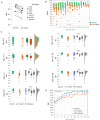Novel At-Home Mother's Milk Conductivity Sensing Technology as an Identification System of Delay in Milk Secretory Activation Progress and Early Breastfeeding Problems: Feasibility Assessment
- PMID: 37464893
- PMCID: PMC10481223
- DOI: 10.2196/43837
Novel At-Home Mother's Milk Conductivity Sensing Technology as an Identification System of Delay in Milk Secretory Activation Progress and Early Breastfeeding Problems: Feasibility Assessment
Abstract
Background: Prolonged exclusive breastfeeding is a public health priority and a personal desire by mothers; however, rates are low with milk supply challenges as a predominant cause. Early breastfeeding management at home is key. Milk electrolytes, mainly sodium ions, are accepted as biomarkers of secretory activation processes throughout the first weeks after birth and predictors for prolonged breastfeeding success, although they are not incorporated into routine care practice.
Objective: The aim of this study was to test the feasibility of a novel handheld smartphone-operated milk conductivity sensing system that was designed to compute a novel parameter, milk maturation percent (MM%), calculated from milk sample conductivity for tracking individual secretory activation progress in a real-world home setting.
Methods: System performance was initially evaluated in data collected from laboratory-based milk analysis, followed by a retrospective analysis of observational real-world data gathered with the system, on the spot in an at-home setting, implemented by lactation support providers or directly by mothers (N=592). Data collected included milk sample sensing data, baby age, and self-reported breastfeeding status and breastfeeding-related conditions. The data were retroactively classified in a day after birth-dependent manner. Results were compared between groups classified according to breastfeeding exclusivity and breastfeeding problems associated with ineffective breastfeeding and low milk supply.
Results: Laboratory analysis in a set of breast milk samples demonstrated a strong correlation between the system's results and sodium ion levels. In the real-world data set, a total of 1511 milk sensing records were obtained on the spot with over 592 real-world mothers. Data gathered with the system revealed a typical time-dependent increase in the milk maturation parameter (MM%), characterized by an initial steep increase, followed by a moderate increase, and reaching a plateau during the first weeks postpartum. Additionally, MM% levels captured by the system were found to be sensitive to breastfeeding status classifications of exclusive breastfeeding and breastfeeding problems, manifested by differences in group means in the several-day range after birth, predominantly during the first weeks postpartum. Differences could also be demonstrated for the per-case time after birth-dependent progress in individual mothers.
Conclusions: This feasibility study demonstrates that the use of smart milk conductivity sensing technology can provide a robust, objective measure of individual breastfeeding efficiency, facilitating remote data collection within a home setting. This system holds considerable potential to augment both self-monitoring and remote breastfeeding management capabilities, as well as to refine clinical classifications. To further validate the clinical relevance and potential of this home milk monitoring tool, future controlled clinical studies are necessary, which will provide insights into its impact on user and care provider satisfaction and its potential to meet breastfeeding success goals.
Keywords: biomarker; breastfeed; breastfeeding; exclusive breastfeeding; feasibility; human milk; infant health; lactation; lactation consultant; lactation support provider; lactogenesis; maternal and child health; maternal and infant health; maternal health; milk; milk maturation; milk supply; mobile health; monitoring tool; mother; prolactin; remote sensing technology; retrospective; secretory activation; sensing technology.
©Sharon Haramati, Anastasia Firsow, Daniela Abigail Navarro, Ravid Shechter. Originally published in JMIR Pediatrics and Parenting (https://pediatrics.jmir.org), 22.08.2023.
Conflict of interest statement
Conflicts of Interest: SH, RS, and AF have financial disclosures related to MyMilk Laboratories Ltd. SH and RS are cofounders of MyMilk Laboratories Ltd and own stock options in the company. AF is an employee of MyMilk Laboratories Ltd. MyMilk Laboratories is a commercial company in the breastfeeding and human milk analysis and support space. The milk sensing device described in this manuscript is in the research and development stage and not commercially available. DAN has no conflicts to declare.
Figures




Similar articles
-
A handheld milk conductivity sensing device (Mylee) for measuring secretory activation progress in lactating women: a device validation study.BMC Pregnancy Childbirth. 2025 Jan 23;25(1):60. doi: 10.1186/s12884-025-07141-x. BMC Pregnancy Childbirth. 2025. PMID: 39849401 Free PMC article.
-
A prospective cohort study on lactation status and breastfeeding challenges in mothers giving birth to preterm infants.Int Breastfeed J. 2022 Jan 10;17(1):6. doi: 10.1186/s13006-021-00447-4. Int Breastfeed J. 2022. PMID: 35012631 Free PMC article.
-
Prepregnant overweight and obesity diminish the prolactin response to suckling in the first week postpartum.Pediatrics. 2004 May;113(5):e465-71. doi: 10.1542/peds.113.5.e465. Pediatrics. 2004. PMID: 15121990
-
Measures of Secretory Activation for Research and Practice: An Integrative Review.Breastfeed Med. 2020 Apr;15(4):191-212. doi: 10.1089/bfm.2019.0247. Epub 2020 Mar 9. Breastfeed Med. 2020. PMID: 32155345 Review.
-
Evidence-Based Updates on the First Week of Exclusive Breastfeeding Among Infants ≥35 Weeks.Pediatrics. 2020 Apr;145(4):e20183696. doi: 10.1542/peds.2018-3696. Epub 2020 Mar 11. Pediatrics. 2020. PMID: 32161111
Cited by
-
A handheld milk conductivity sensing device (Mylee) for measuring secretory activation progress in lactating women: a device validation study.BMC Pregnancy Childbirth. 2025 Jan 23;25(1):60. doi: 10.1186/s12884-025-07141-x. BMC Pregnancy Childbirth. 2025. PMID: 39849401 Free PMC article.
References
-
- Rollins NC, Bhandari N, Hajeebhoy N, Horton S, Lutter CK, Martines JC, Piwoz EG, Richter LM, Victora CG, Lancet Breastfeeding Series Group Why invest, and what it will take to improve breastfeeding practices? Lancet. 2016 Jan 30;387(10017):491–504. doi: 10.1016/S0140-6736(15)01044-2.S0140-6736(15)01044-2 - DOI - PubMed
-
- Breastfeeding rates. National Immunization Survey (NIS) Centers for Disease Control and Prevention. 2018. [2023-07-20]. https://www.cdc.gov/breastfeeding/data/nis_data/index.htm .
-
- Pérez-Escamilla R, Tomori C, Hernández-Cordero S, Baker P, Barros AJD, Bégin F, Chapman DJ, Grummer-Strawn LM, McCoy D, Menon P, Ribeiro Neves PA, Piwoz E, Rollins N, Victora CG, Richter L, 2023 Lancet Breastfeeding Series Group Breastfeeding: crucially important, but increasingly challenged in a market-driven world. Lancet. 2023 Feb 11;401(10375):472–485. doi: 10.1016/S0140-6736(22)01932-8. https://linkinghub.elsevier.com/retrieve/pii/S0140-6736(22)01932-8 S0140-6736(22)01932-8 - DOI - PubMed
LinkOut - more resources
Full Text Sources

